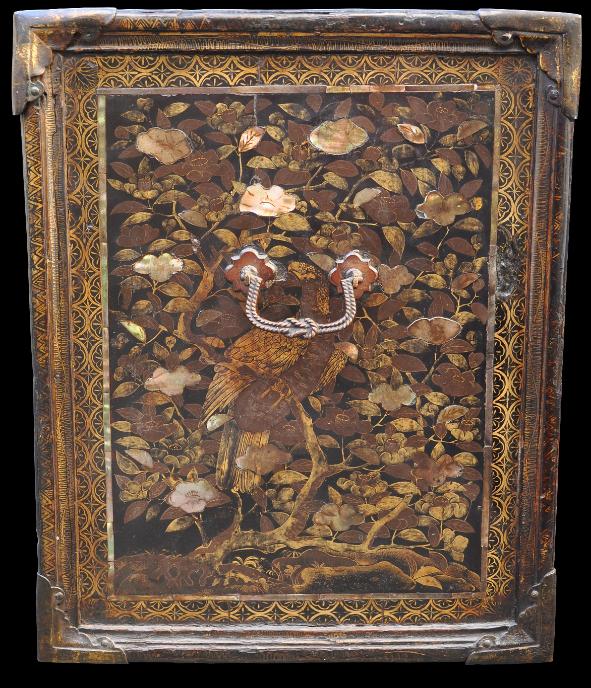
Namban Indo-Portuguese Cabinet
Namban Front-Fall Cabinet made for the Portuguese Market
Japan
1580-1620
width: 64cn, height: 43cm, depth: 34cm
This chest, made in Japan towards the end of the sixteenth century specifically for the Portuguese market, is a fine example of what is known as Namban lacquerware.
Pope Gregory XIII granted Portugal in 1580 exclusive rights to maritime trade east of the Red Sea to as far as seventeen degrees east of the Moluccas (in today’s eastern Indonesia). Japan thus became one of the new sources for exotic luxury goods that could be imported to Europe for profit. Lacquered chests and other objects inlaid with mother-of-pearl were acquired by the Portuguese from Gujarat in India but the superiority of Japanese mother-of-pearl inlaid lacquer was quickly noticed and so Japan became a new source to feed European demand.
The chests and other objects were lacquered in black (
urushi), decorated with gold and silver dust (maki-e) and then inlaid with pearl shell (raden). The items became known in Japan as namban, literally ‘southern barbarian’ but perhaps more appropriately translated as ‘exotic’, and was a reference to the Portuguese who commissioned the goods.
The growth in the Portugal-Japan trade was remarkable for it was only in 1542 or 1543 that the first Europeans visited Japan – three Portuguese sailors landed at Tanegashima after the Chinese junk in which they were sailing apparently was blown off course. The Jesuit missionary Francis Xavier arrived in 1549 (see
here
for an ivory image of Xavier.) The Jesuits made big, early inroads and were particularly successful at propagating Christianity in the south. It is likely that the first Namban lacquewares made for the Portuguese were in fact made for the Jesuits.
The cabinet here is larger than most extant examples. The top, sides and front fall are decorated with gold and silver foliage interspersed with pearl shell against a black
urushi background. The sides benefit from the addition of a single large bird – perhaps an eagle – standing amid tea camellias that have flowers rendered delicately in pearl shell. There is a metal handle to each side and the external corners are fitted with (formerly) gilded and engraved copper mounts.
The fall front that comes down to reveal eleven hidden drawers, each with fronts decorated in the same manner as the exterior of the cabinet. The lacquerwork here is particularly fresh and crisp. Each drawer retains its original copper drawer pull. The sides and interior are decorated with black
urushi.
The interior of the front fall has been left plain. Perhaps this is part of the variation seen among Namban chests, or the front fall has been replaced with what might have been the decorated rear panel. If this is so, then the adjustment was made perhaps more than a century ago, for the back panelling today has substantial age itself if not as old as the cabinet itself.
The borders of each drawer as well as the interior sides of the cabinet itself are richly decorated with what is known as Namban scrollwork (Impey & Jorg, 2005). Indeed, the Namban scrollwork shown on this cabinet is among the most extensive of any Portuguese Namban chest published.
The lacquerwork is stable. There are no obvious losses. There is age-related fading, particularly to the top as can be expected, but remarkably there are no apparent losses to the pearl shell inlay. The front fall shows some slight shrinkage-related cracking but elsewhere the cabinet is free of cracks. Overall, the cabinet is in remarkably good condition particularly compared with many extant examples even in public collections. The cabinet is in its original state as we have found it; no recent repairs or restoration has been attempted.
Similar examples are in the collections of the Ashmolean Museum, Oxford; the Kunsthistorisches Museum, Vienna; and the Kyoto National Museum, Kyoto.
References
Bennett, J., & A. Reigle Newland, The Golden Journey: Japanese Art from Australian Collections, Art Gallery of South Australia, 2009.
Cattaneo, A.
, et al, Portugal and the World: In the 16th and 17th Centuries, Museu Nacional de Arte Antiga, Lisbon, 2009.
Christie’s London, ‘Important Jesuit Lacquers and Japanese Works of Art from the Age of Western Influence’, November 19, 1985.
Clode Sousa, F.,
et al, Obras de Referencia dos Museum da Madeira, Instituto dos Museus e da Conservacao, 2009.
Flores, J.M.
et al, Os Constructores do Oriente Portugues, Comissao Nacional para as Comemoracoes dos Descobrimentos Portugueses, 1998.
Impey, O., & C. Jorg,
Japanese Export Lacquer 1580-1850, Hotei Publishing, 2005.
Museum of Christian Art, Rachol, Goa, 1993.Inventory no.: 1575
SOLD
to see another example of Namban lacquer for the Portuguese market.














‘Namban scrollwork’ along the interior sides of the chest (above and below).
The back of the cabinet.


